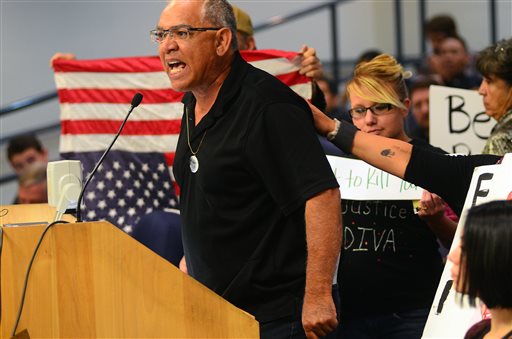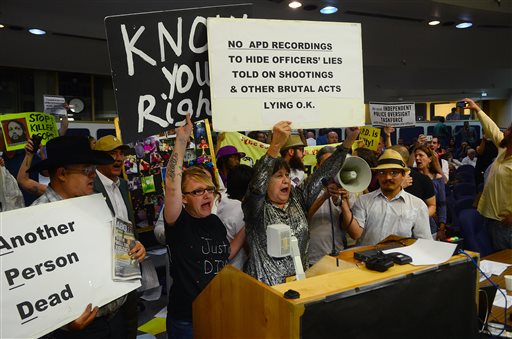National
What’s Next for Troubled Albuquerque Police?


Protesters take over the City Council meeting, Monday May 5, 2014, in Albuquerque, N.M. Alan Gomez was fatally shot by an APD officer in 2011. (AP Photo/The Albuquerque Journal, Bob Brawdy)
RUSSELL CONTRERAS, Associated Press
ALBUQUERQUE, N.M. (AP) — Outcry over recent police shootings continues to rattle New Mexico’s largest city, spreading from street protests to rowdy demonstrations in government buildings.
Angry protesters took control of an Albuquerque City Council meeting this week, demanding the police chief’s firing, shouting at council members and causing such a ruckus that the panel’s president adjourned the meeting. Activists vow to return to Thursday’s rescheduled gathering.
The backlash followed the latest police shooting this month and added to a series of recent protests over the nearly 40 shootings by Albuquerque officers since 2010. The Police Department faces intense scrutiny after the U.S. Justice Department recently released a harsh report on officers’ use of force and interactions with suspects with mental illness.
Here are some key questions as federal investigators work with the city on reforms.
WHAT HAPPENED THIS MONTH?
An Albuquerque officer shot and killed a 50-year-old father Saturday during a lengthy standoff. His wife had reported he threatened her and their two children with a gun. Authorities said Armand Martin came out of his Albuquerque home firing two handguns, and a video clip released Tuesday shows the man brandishing a firearm as his family rushes out of the home. Police said Martin fired at least 11 shots from inside and outside the home before a SWAT team member fired a single shot that struck his chest. Martin died at the scene. On Monday, a City Council meeting grew heated as one man called for a “citizen’s arrest” of Police Chief Gorden Eden. The crowd then began chanting for the chief’s ouster and Mayor Richard Berry’s recall as demonstrators flooded the front rows of the council chamber with their signs and banners. Councilors walked out as protesters held a mock meeting.
WHAT’S CHANGED?
After years of small protests and occasional community town-hall gatherings, demonstrations exploded after the March 16 shooting death of homeless camper James Boyd, 38, in the foothills of the Sandia Mountains during a long standoff. Video from an officer’s helmet camera showed police fired on Boyd, who had struggled with mental illness, as he appeared to be preparing to surrender. He died at a nearby hospital, and the FBI said it would investigate. Days later, a demonstration turned violent, leading police to use tear gas on street protesters who halted traffic, threw rocks and bottles, and damaged property. The protest drew national attention and followed a YouTube video that threatened retaliation for Boyd’s death. The video, which bore the logo of the computer hacking collective Anonymous, warned of a cyberattack on city websites and called for the protest. City officials reported that some websites went down due to a cyberattack.
WHAT DID THE U.S. JUSTICE DEPARTMENT DO?
The federal agency released a scathing report in April, revealing a troubling pattern of excessive force by the Albuquerque Police Department and recommending the city become the latest U.S. municipality to adopt reforms aimed at reforming its police force. The report, which immediately drew support from the mayor, came after federal officials spent months conducting interviews, scouring videos and reviewing hundreds of pages of documents. According to the report, Albuquerque officers too frequently used deadly force on people who posed a minimal threat and used a higher level of force too often on those with mental illness, often violating their constitutional rights.
WHEN WILL REFORMS BE ANNOUNCED?
Berry, the mayor, said city officials would begin negotiations with the Justice Department on a blueprint for police reforms, which would likely include better training for officers and possible changes to internal affairs. Officials acknowledged that a possible consent decree could leave Albuquerque with a bill totaling millions of dollars, as similar agreements did in New Orleans and Portland, Oregon. In the wake of the Justice Department report, Berry announced that former American Civil Liberties Union lawyer Scott Greenwood and former Cincinnati police Chief Tom Streicher would lead a team negotiating a reform plan with federal officials. The men are former adversaries in a federal investigation into Cincinnati police and were key figures in helping Cincinnati craft similar reforms in a 2002 agreement. An agreement could be months away.
WHAT ARE ALBUQUERQUE POLICE DOING IN THE MEANTIME?
The department is working on training officers in dealing with suspects with mental illness. All officers are also required to record interactions with the public on lapel cameras. City councilors are considering two proposals aimed at reforming the hiring process for its police chief. One measure calls for councilors to confirm a future chief while another would require voters to elect the official.
Copyright 2014 The Associated Press. All rights reserved. This material may not be published, broadcast, rewritten or redistributed.

































